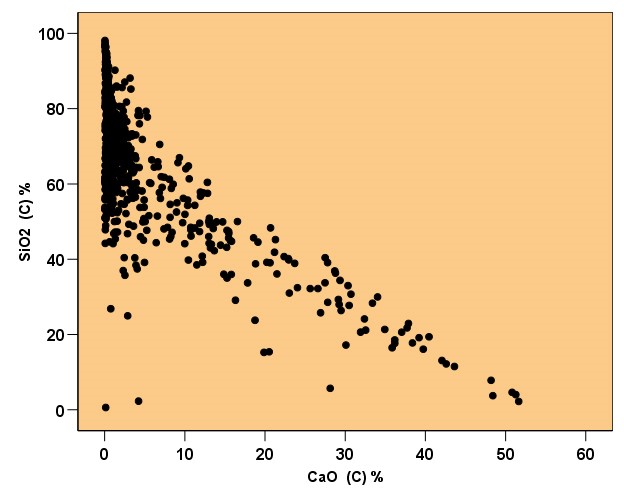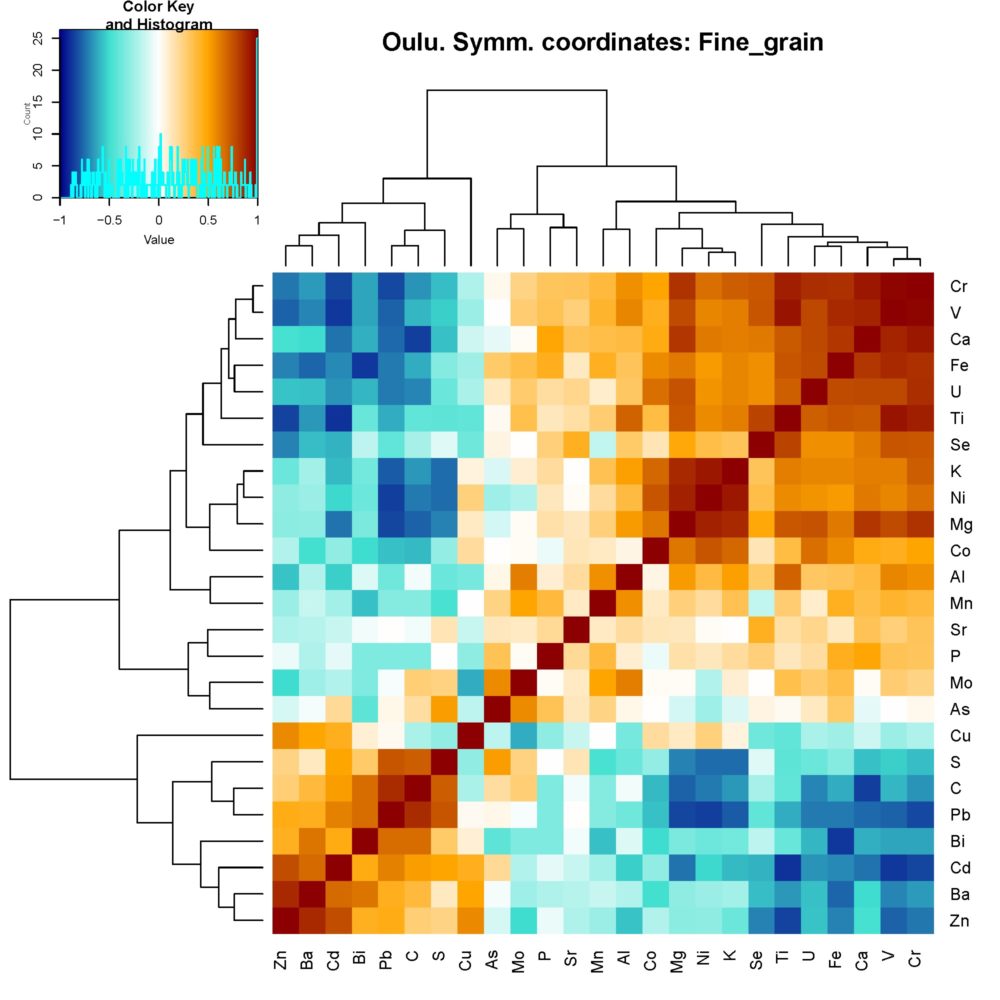Science Blog: Heatmaps – a new insight into the geochemistry of urban soil
Geochemical data have a special characteristic: the concentrations of elements are mutually dependent. All of our soil samples are 100% composed of elements. If we have 70% silica (SiO2) in a sample, there cannot be more than 30% of other elements. Figure 1 provides a nice example of the SiO2 and CaO contents in European soil parent material. Until recent years, geochemists have used element concentrations as variables in statistical analysis and have calculated mean values, standard deviations or correlation coefficients. However, this is mathematically not exactly correct, as the variables are dependent on each other. Geochemical data are a typical example of compositional data.

We wanted to understand which elements behave in a similar way in Finnish urban soil materials and tried to avoid effects caused by the compositional character of geochemical data. Data were available from seven Finnish towns that the Geological Survey of Finland had studied during the Soil Geochemical Baselines project: Heinola, Kuopio, Lahti, Oulu, Rovaniemi, Tampere and Vaasa (Tarvainen et al. 2009). There are mathematical ways to open the variable space of compositional data. We used the so-called isometric log-ratio (ilr) transformation for 25 elements measured from Finnish urban soil parent material samples. These ilr-transformed variables were presented by using heatmap plots (Fig. 2).

The heatmap plot in Figure 2 presenting the fine-grained soils of Oulu illustrates that Al, K, Mg, Fe, Cr, U, V, Ti, Ni and Co are strongly bound to mica and clay minerals, mostly to biotite. C, S, Pb, Bi, Cd, Ba, Zn and partly Cu are bound to organic matter in natural fine-grained sediments.
Urban topsoil samples from all seven towns were divided into four groups: natural fine-grained sediments, natural coarse-grained sediments, man-made fillings dominated by minerogenic soil material and man-made fillings rich in organic matter. The same main groups of elements were found in all the towns and in almost all soil types: elements explained by the abundance of mica minerals and elements bound to soil organic matter. Metals bound to mica minerals mostly represent the natural geogenic background, while topsoil organic matter can easily bind deposited lead, cadmium and mercury. Some heatmaps revealed specific groups. For example, Zn, Pb, Mo and Cd formed a group of elements in man-made fillings in Lahti. These elements are common in urban environments and we considered them to have an anthropogenic origin.
Compositional data analysis and heatmap plots provided us an informative graphical tool to understand factors that determine the distribution of elements in Finnish urban soil parent material.
Reference:
Tarvainen, T., Sapon, S. & Jarva, J. 2019: Applying heatmaps in interpretation of geochemical baseline data on urban soils in Finland. Journal of Geochemical Exploration DOI 10.1016/j.gexplo.2019.106345
Text: Timo Tarvainen, Svetlana Sapon and Jaana Jarva
Dr Timo Tarvainen is a Senior Scientist in the Environmental Solutions unit, specializing in geochemistry and the urban environment. He has been at the Geological Survey of Finland (GTK) since 1986, carrying out local, national and international geochemical mapping projects, as well as statistical analysis of geochemical data. He is currently focusing on the development of the national soil geochemical baseline database.
Ms Svetlana Sapon is a geophysicist in the Information Solutions unit. She has worked at the Geological Survey of Finland (GTK) since December 1999, participating in national and international projects specialising in the management of geological data. She is currently focusing on the development of geological and geochemical databases and their graphic illustration (heatmaps) for geochemical analysis.
Dr Jaana Jarva is a senior scientist in the Environmental Solutions unit. She has worked at the Geological Survey of Finland (GTK) since June 1996, carrying out research projects on environmental and urban geology, geochemistry, groundwater, land use planning and climate change adaptation in Finland and overseas. Her current research interests are focused on environmental risk assessment, the circular economy and sustainable water management.
